Numismatic: Argentine Ancient Coins
After the pronouncement of May 1810, Buenos Aires and the other provinces of the Río de la Plata began the campaign of independence, sending expeditions to the High Peru, focus of realistic resistance. The Argentines took the Imperial Villa of Potosi with their mint. Coins were minted in 1810, 1813 and 1815: the last two occupations were important from the monetary point of view, since the type that was issued until then with the real bust and Hispanic emblems – was changed by new coins that bore the symbols patriotic Union and Freedom. The same happened in the Philippines with coins minted in America, which were countermarked
Mint of Potosi
Potosi (for Argentine). Rio de la Plata. 1813 – J Jose Antonio de la Sierra ( Assayer)
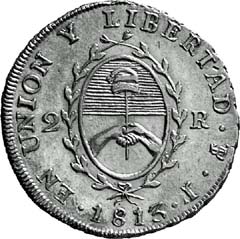
2 Reales
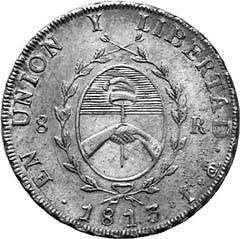
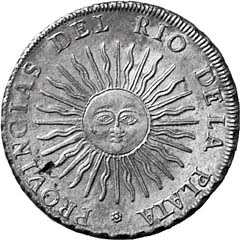
8 Reales
The patriotic victory of Salta in February 1813, left the free passage to the Argentine Auxiliary Army under the command of General Manuel Belgrano on May 7 of that year occupy Potosí. This city had been evacuated by March 10. The Casa de Moneda was the object of greater attention, rehabilitating it, as the realists had plundered it by destroying materials, books and documents. In Buenos Aires, the General Constituent Assembly receives a draft from the Deputy Dr. Pedro J. de Agrelo that proposes, as an eminently political measure, the minting of an independent type of currency. The only alterations of the seal, replacing in the open dies the Spanish shield and the royal bust of Fernando VII by the seal of the Assembly and by the May sun.
1815
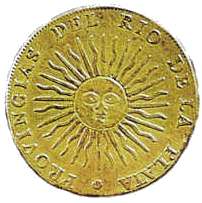
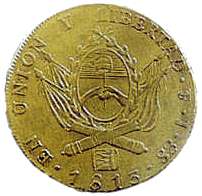
8 Soles
Law 21 carats. 875 thousandths, weight: 27 grams. Fine gold: 23.6 grams. Edge: oblique grooving. Approximate module: 35 mm. There are 8 (eight) known copies in different museums. Shield with cannons and Drum
These First Coins of Argentina
Were coined in gold in the values of 8, 2 and 1 escudos, and in silver in 8, 4, 2, 1 and ½ reales. There is no proof that shields of four have been sealed. Many officers of the Mint fled and for this reason they had to ascend to junior officers. Almost all were not trained enough to exercise the new positions, having committed many faults.
For example, the 2nd officer Pedro Venavidez was promoted to Mayor coiner and the office of assayer was entrusted to José Antonio de Sierra. It began with the minting of silver coins at the end of June. The pieces of gold are today of great rarity; Silver minting, on the other hand, was abundant in all values.
1815
Potosi ( For Argentine).Rio de la Plata. F Francisco Jose de Matos & Leandro Ozio
8 Soles (Gold)
(S) SOL replaces the Spanish Coin (S) Escudo (SHIELD) in 1815
They show on the obverse a radiant sun, with eyes, nose, mouth and thirty-two straight and flamboyant rays alternating. The circular legend begins with PROVINCES OF THE RIO DE LA PLATA and continues on the other side with UNION AND FREEDOM. On the back there is a national emblem then seal of the Assembly – without sun and simple silver coins; with trophies formed by two crossed cannons, two side flags and a drum at the foot in the gold ones.
Argentine. 8 Reales Mint of La Rioja (RA) Assayer P
United Provinces of the Rio de la Plata. Mint of La Rioja,
1826
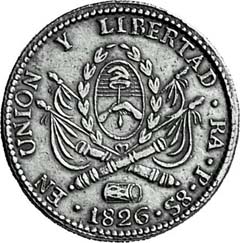
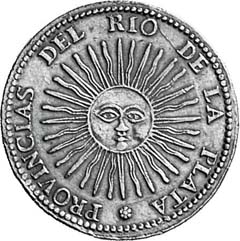
They also have the PTS monogram that identifies the Potosi mint. The initial J. corresponds to the assayer José Antonio de Sierra. The song of the silver coins has the shape of laurel leaves, while that of the gold pieces is obliquely striated.
The last delivery of Coins was made on November 18, 1813, the same day that General Belgrano began his strategic withdrawal to Jujuy after the defeat in the Battle of Ayohuma. Many of the offices of the Casa de Moneda were destroyed with the purpose of depriving the Spanish Realists of a quick issuance of Coins, who only on December 9 could restart the coinage with the bust of Fernando VII.
1815
Potosi (For Argentine).Rio de la Plata. L Leandro Ozio (Assayer)
8 Reales
On December 22, 1813, a notice was published, ordering the exchange of all the coins that were sealed for the Provinces of the Río de la Plata by those that had the bust of the King, giving a term of three days to the neighbors of the Villa Imperial de Potosi and three months to the neighbors of the nearby Provinces. But the population was reluctant to surrender, foreseeing a new occupation of Argentine troops. That happened in April of 1815; then the units commanded by General Jose Rondeau reconquered Potosi and the old mint again coined national currencies. On this occasion only pieces of silver were issued with the value in reais. Then, in the middle of the same year, a similar series was developed but with the value expressed in soles.
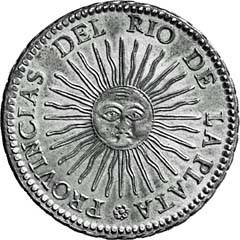
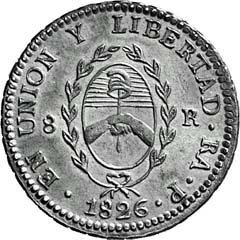
The change coincided with the entry into operation of a new assayer, as it was not possible to count on Sierra, who had acted in 1813. Because of this circumstance, the reals of 1815 show the initial F. corresponding to Francisco José de Matos.
In the denominated currencies soles of the same year, the F. appears accompanied of an L. by Leandro Ozio. Both improvised assayers and for that reason the coins of 1815 are of lower quality than fine established in the ordinances.
The qualified engraving revolutionary authorities could not find either, because they fled they fled with the king’s troops and the office of minting had to be improvised with subordinate and amateur personnel. In this regard, spelling errors are noted in the pieces of 8 reales, knowing one copy coined with the word PRORVINCIAS and another with PROVICIAS.
The coins of 1815 are more abundant than those of 1813. Their coinage ceased with the defeat of General Rondeau in the Battle of Sipe-Sipe and the evacuation of Potosi which fell again into the hands of the Spaniards. Ten years later it became a city of the new Republic of Bolivia.
Argentine Ancient Coins: Enhene losing the mint of Potosi and the provinces of the High Peru, a remarkable shortage of currencies took place in all the Argentine North. The coins with the bust of the king disappeared from the market, leaving the old macuquinas, later falsified in great scale.
It should be noted that, having been minted for the last time in Potosi in 1773, these cut coins still circulated: they could only be eradicated in the second half of the 19th century.
Argentine Ancient Coins
1815
Potosi (For Argentine).Rio de la Plata. L Leandro Ozio
8 Reales
1828
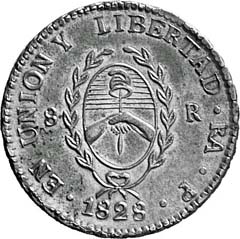
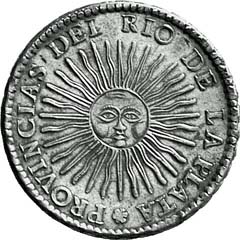
1832
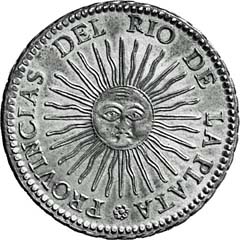
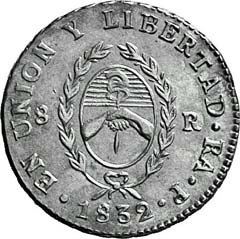
1834
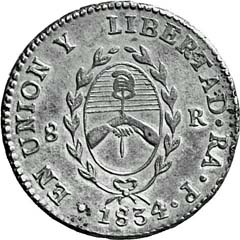
1836
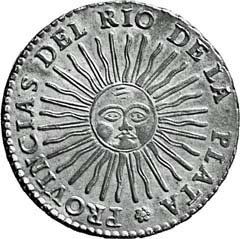
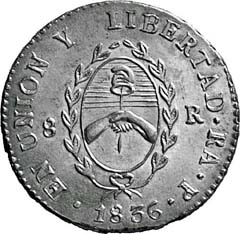
1838
Argentine Ancient Coins. Federal Rosist Currency
Mint of La Rioja
Confederate Republic of Argentina. (Republica Argentina Confederada)
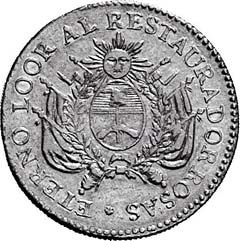
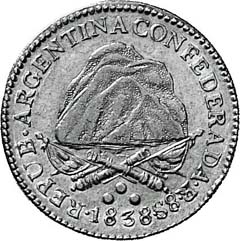
8 Escudos
Famatina mountain background, shield with Flags and the legend Eternal Loor to the Restorer (Eterno Loor al Restaurador ) and cannons. Denomination 8 Shields such as the Spanish monetary system.
The Restaurador is Juan Manuel de Rosas, leader of the Confederate side in the Argentine Civil War.
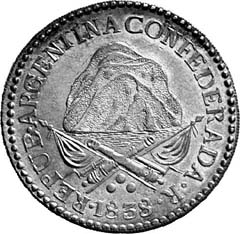
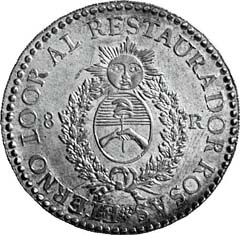
8 Reales
Famatina mountain background, shield with laurels and the legend Eternal Loor to the Restorer (Eterno Loor al Restaurador ) and cannons. Denomination 8 Shields such as the Spanish monetary system.
1840
Argentine Ancient Coins . 8 Reales – Unitary Currency First Version – Argentine Civil War
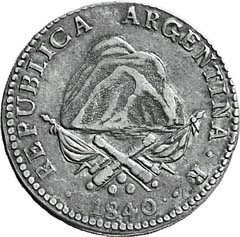
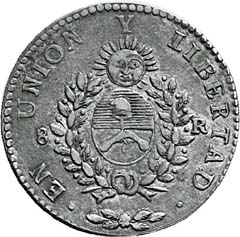
Famatine mountain background, shield with laurels and sentence: IN UNION AND FREEDOM (EN UNION Y LIBERTAD ) and cannons such as the first coin of 1813 Denomination 8 Shields ( Escudos) . It is called rebel weight, first version. When General Brizuela lost power in the province of La Rioja evicted from power by the Unitarians, the governor who replaced them (federal) issued these coins, until La Rioja was retaken in 1841 by the federal troops, which reissued the Federal currency. The Legend REPUBLICA ARGENTINA appears for the first time. Argentine Ancient Coins
1840
Argentine Ancient Coins. 8 Escudos Unitary Currency Second Version – Argentine Civil War
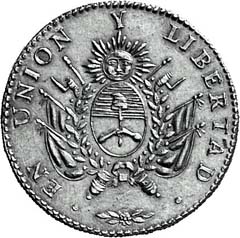
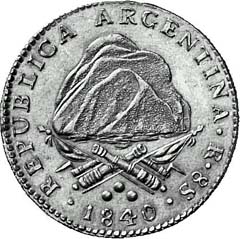
The shield of the Argentine nation is surrounded by flags 8 Escudos
1840
Copper Coin of the Province of Buenos Aires. Government of J.M. Rosas
Dos Reales
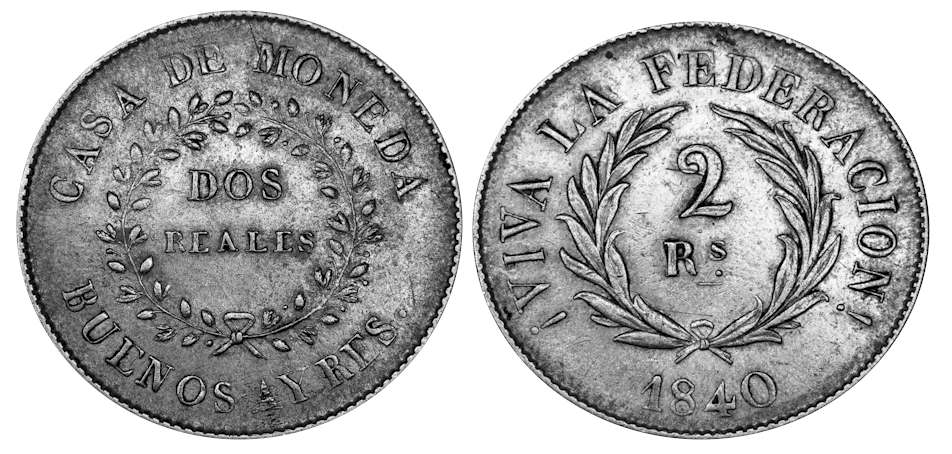
1840
Argentine Ancient Coins . 8 Reales – Unitary Currency First Version – Argentine Civil War


Famatine mountain background, shield with laurels and sentence: IN UNION AND FREEDOM (EN UNION Y LIBERTAD ) and cannons such as the first coin of 1813 Denomination 8 Shields ( Escudos) . It is called rebel weight, first version. When General Brizuela lost power in the province of La Rioja evicted from power by the Unitarians, the governor who replaced them (federal) issued these coins, until La Rioja was retaken in 1841 by the federal troops, which reissued the Federal currency. The Legend REPUBLICA ARGENTINA appears for the first time. Argentine Ancient Coins
1840
Argentine Ancient Coins. 8 Escudos Unitary Currency Second Version – Argentine Civil War


The shield of the Argentine nation is surrounded by flags 8 Escudos
1843
Confederacion Argentina 2 Reales Gold
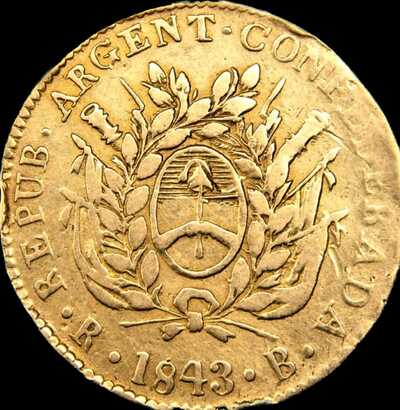
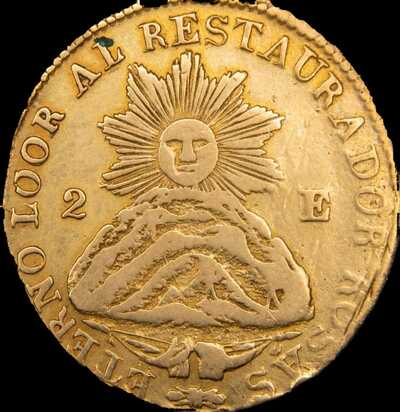
1852
Argentine Ancient Coins. 8 Reales Mint of Cordoba.
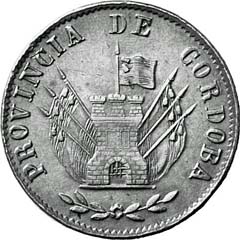
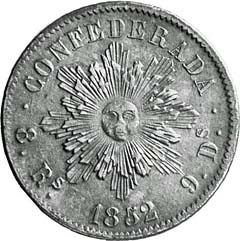
The mint of 8 reales of 1852 belongs to the provincial emission. Neither the word Argentina nor Republica appear on either side. Corresponds to a period of high institutional instability and national identity. It belongs to a coinage ordered by the caudillo in power at that moment, that as it was seen in the mint of the Rioja, modified the images to the pleasure of the ruler of the day. Denomination 8 Reales, following the Spanish tradition.
Related Post
- Amazing history of treadwheel crane of Chatedral of Strasbourg - France
- Travel Argentina Glacier
- Luggage & Suitcases
- Best luggage for travelers
- Best travel Gadgets 2021 - Click here for more info
- Search Products on amazon , Here
- Real of Eight


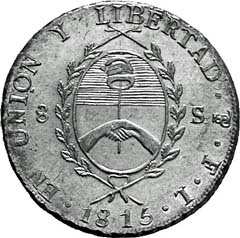
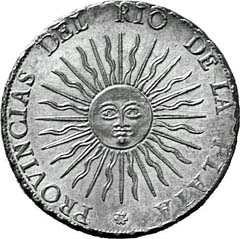

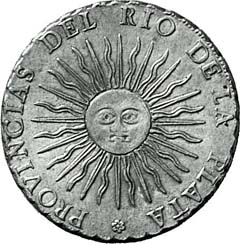
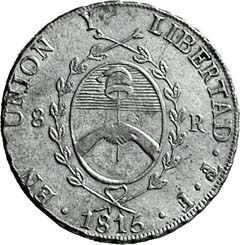

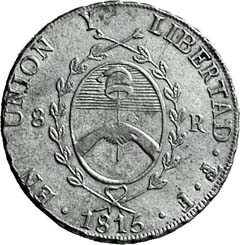
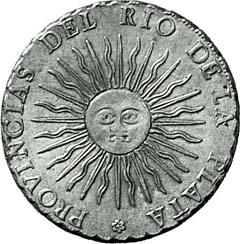



Howdy, There’s no doubt that your website could possibly
be having internet browser compatibility problems.
When I look at your blog in Safari, it looks fine however, when opening in Internet Explorer, it’s got some
overlapping issues. I just wanted to give you a quick heads up!
Aside from that, excellent site!
Good afternoon. A short comment. The gold Coin named “8 soles” and dated 1815 do not exist, beacause not gold Coins were minted in Potosí this year. Only silver Coins in Reales or Soles was minted in 1815.
The ilústrated gold Coin is an 8 scuti (latín denomination) “8S” equal to 8 Escudos (shields) and The year of mint was only 1813 for the Patriot gold coinage. No mint in 1815.
References: Arnaldo Cunietti-Ferrando “Monedas Argentinas…” Bs.As. 1989.
Héctor Carlos Janson “La Moneda Circulante en el Territorio Argentino 1574-2019” Bs.As. 2020.
Thanks.